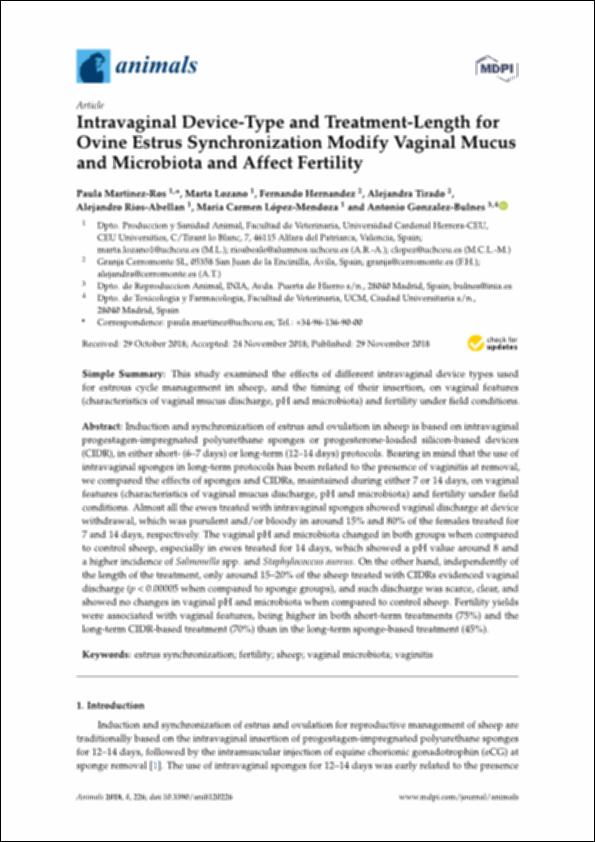Por favor, use este identificador para citar o enlazar este ítem:
http://hdl.handle.net/10637/9973Intravaginal device-type and treatment-length for ovine estrus synchronization modify vaginal mucus and microbiota and affect fertility
| Título : | Intravaginal device-type and treatment-length for ovine estrus synchronization modify vaginal mucus and microbiota and affect fertility |
| Autor : | Martínez Ros, Paula Ríos Abellán, Alejandro Tirado, Alejandra Lozano Fuentes, Marta Hernández, Fernando López Mendoza, María Carmen |
| Materias: | Reproduction.; Ovejas - Reproducción.; Sheep - Reproduction.; Estro.; Sheep - Fertility.; Estrus.; Reproducción animal.; Ovejas - Fecundidad. |
| Editorial : | MDPI. |
| Citación : | Martínez Ros, P., Lozano, M., Hernández, F., Tirado, A., Ríos Abellán, A., López Mendoza, MC. and González Bulnes, A. (2018). Intravaginal device-type and treatment-length for ovine estrus synchronization modify vaginal mucus and microbiota and affect fertility. Animals, vol. 8, n. 12 (diciembre 2018), art. 226. |
| Resumen : | Induction and synchronization of estrus and ovulation in sheep is based on intravaginal progestagen-impregnated polyurethane sponges or progesterone-loaded silicon-based devices (CIDR), in either short- (6–7 days) or long-term (12–14 days) protocols. Bearing in mind that the use of intravaginal sponges in long-term protocols has been related to the presence of vaginitis at removal, we compared the effects of sponges and CIDRs, maintained during either 7 or 14 days, on vaginal features (characteristics of vaginal mucus discharge, pH and microbiota) and fertility under field conditions. Almost all the ewes treated with intravaginal sponges showed vaginal discharge at device withdrawal, which was purulent and/or bloody in around 15% and 80% of the females treated for 7 and 14 days, respectively. The vaginal pH and microbiota changed in both groups when compared to control sheep, especially in ewes treated for 14 days, which showed a pH value around 8 and a higher incidence of Salmonella spp. and Staphylococcus aureus. On the other hand, independently of the length of the treatment, only around 15–20% of the sheep treated with CIDRs evidenced vaginal discharge (p < 0.00005 when compared to sponge groups), and such discharge was scarce, clear, and showed no changes in vaginal pH and microbiota when compared to control sheep. Fertility yields were associated with vaginal features, being higher in both short-term treatments (75%) and the long-term CIDR-based treatment (70%) than in the long-term sponge-based treatment (45%). |
| Descripción : | Este artículo se ha publicado de forma definitiva en https://www.mdpi.com/2076-2615/8/12/226 |
| URI : | http://hdl.handle.net/10637/9973 |
| Derechos: | http://creativecommons.org/licenses/by/4.0/deed.es |
| ISSN : | 2076-2615. |
| Fecha de publicación : | 1-dic-2018 |
| Centro : | Universidad Cardenal Herrera-CEU |
| Aparece en las colecciones: | Dpto. Producción y Sanidad Animal, Salud Pública Veterinaria y Ciencia y Tecnología de los Alimentos |
Los ítems de DSpace están protegidos por copyright, con todos los derechos reservados, a menos que se indique lo contrario.


